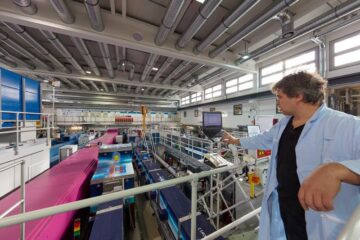Terabit Optical Burst Sampling – Method and Design for Single-shot Optical Sampling

<strong>Technology</strong><br>
The characterization of a single laser pulse in real-time is of great interest. Here, the difficulty of detection originates from the required resolution in time (about a factor of ten higher than the measuring pulse). This concerns not only the sampling resolution but the sampling rate as well.<br><br> The invention allows single-shot laser pulse characterization with a time resolution in the THz regime. It consists of a laser system that provides the sampling pulse, an optical element (e.g. non-linear crystal) which generates the measuring signal through superposition of the sampling pulse and the measuring pulse, and a third element for the detection.<br><br> The method based on the transformation of the problem from the time domain into the spectral domain. The sampling laser is a laser system which provides light pulses that have different wavelengths at different time. With an optical element (e.g. grating) it is possible to seperate the wavelength components in space. Therefore, the detection of the sampling points with minimal spatial distance is possible without any problem. This means, every spectral component can be assigned to a distinct time. <br><br> This single-shot optical sampling offers a resolution in the femtosecond time domain.<br><br> <strong>Benefits</strong><br> <ul> <li>High time resolution (THz regime)</li> <li>Single-shot characterization</li> </ul><br> <strong>IP Rights</strong><br> German Patent DE 10 2006 045 835<br> <br> <strong>Origin</strong><br> Technische Universität Berlin, Germany</p>
Weitere Informationen: PDF
ipal GmbH
Tel.: +49 (0)30/2125-4820
Ansprechpartner
Dr. Dirk Dantz
Media Contact
Alle Nachrichten aus der Kategorie: Technologieangebote
Neueste Beiträge

Bakterien für klimaneutrale Chemikalien der Zukunft
Forschende an der ETH Zürich haben Bakterien im Labor so herangezüchtet, dass sie Methanol effizient verwerten können. Jetzt lässt sich der Stoffwechsel dieser Bakterien anzapfen, um wertvolle Produkte herzustellen, die…

Batterien: Heute die Materialien von morgen modellieren
Welche Faktoren bestimmen, wie schnell sich eine Batterie laden lässt? Dieser und weiteren Fragen gehen Forschende am Karlsruher Institut für Technologie (KIT) mit computergestützten Simulationen nach. Mikrostrukturmodelle tragen dazu bei,…

Porosität von Sedimentgestein mit Neutronen untersucht
Forschung am FRM II zu geologischen Lagerstätten. Dauerhafte unterirdische Lagerung von CO2 Poren so klein wie Bakterien Porenmessung mit Neutronen auf den Nanometer genau Ob Sedimentgesteine fossile Kohlenwasserstoffe speichern können…

















